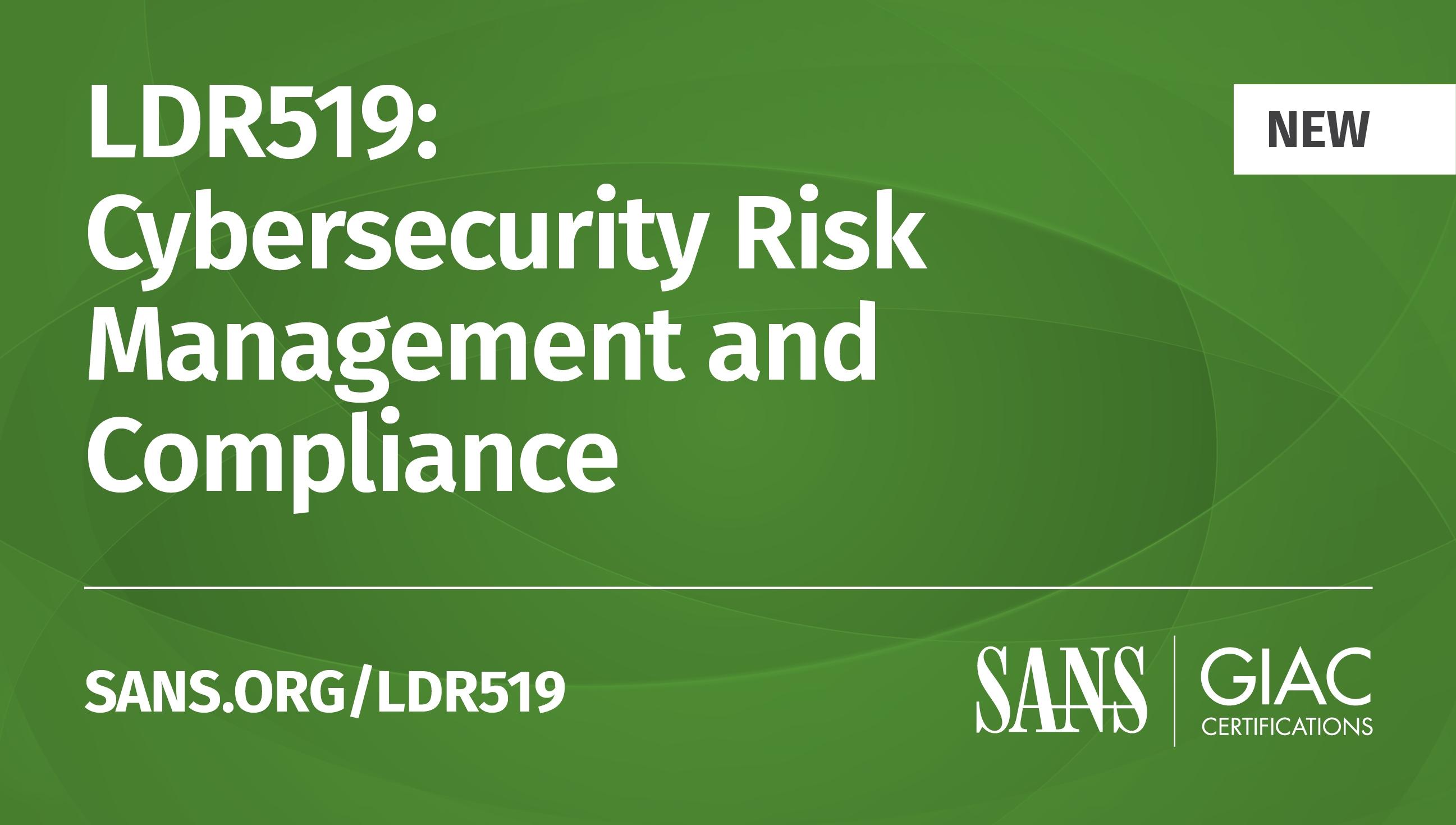SEC595: Applied Data Science and AI/Machine Learning for Cybersecurity Professionals


Experience SANS training through course previews.
Learn MoreLet us help.
Contact usBecome a member for instant access to our free resources.
Sign UpWe're here to help.
Contact UsIntroducing the new SANS LDR519: Cybersecurity Risk Management and Compliance course.

Introducing the new SANS LDR519: Cybersecurity Risk Management and Compliance course. This advanced course delves into the theories and philosophies of cybersecurity risk management, providing a deep understanding of principles guiding organizational decisions. LDR519 covers cybersecurity threat models, safeguard frameworks, and long-term risk management skills. By combining theoretical knowledge with practical application, LDR519 prepares students to maintain robust defenses and navigate the evolving threat landscape.
My name is James Tarala, and I have been researching, writing content, and teaching for SANS Institute since 2002. In that time, I've taught dozens of different cybersecurity classes and participated in numerous consensus research projects that I hope have contributed to the overall body of cybersecurity knowledge. Writing a SANS course, and definitely writing two SANS courses, is a labor of love, and I want students to know why I took the time to write these classes and why I think they are so crucial to organizations today. Indeed, students can read the course descriptions for each course to understand what is covered in each course, but I wanted students to understand why I wrote them.
In Simon Sinek’s book, Start with Why: How Great Leaders Inspire Everyone to Take Action, he states, "All organizations start with WHY, but only the great ones keep their WHY clear year after year." I am writing this blog post to encourage my students and myself to remember why the principles of cybersecurity risk management are still vital to organizations today and to provide a north star for LDR419 and LDR519 in the future. I hope this post helps us all focus on the importance of this content.
It truly is my belief, and the belief of SANS Institute, that every organization can benefit from performing a cybersecurity risk assessment and engaging in cybersecurity risk management practices. By identifying, assessing, and mitigating potential threats effectively, cybersecurity risk management enables organizations to protect critical assets, maintain stakeholder trust, and ensure operational continuity. This proactive approach empowers professionals to make informed decisions, prioritize resources efficiently, and comply with regulatory standards, ultimately creating a cybersecurity posture that can adapt to the evolving threat environment. In a world where cyber threats are increasingly sophisticated and pervasive, mastering cybersecurity risk management is essential for safeguarding information systems, preserving data integrity, and sustaining organizational resilience against cyber-attacks.
In short, cybersecurity risk management helps organizations create a cybersecurity strategy, which helps ensure an organization’s technology systems continue to operate as intended. This, in turn, helps ensure the organization’s technology systems enable an organization to achieve its mission.
Effective risk management serves as a guiding light for organizations grappling with the complexities of safeguarding their digital assets. Cybersecurity risk management empowers businesses to navigate the evolving threat landscape with clarity and purpose, ensuring resilience and informed decision-making. Without this information, organizations tend to wander and lose focus. Without this foundation, it is easy for organizations to gravitate towards trendy defenses rather than focusing on the safeguards with the greatest likelihood of helping achieve its goals.
Every week I talk with organizations struggling to maintain a meaningful strategy for cybersecurity. Some of the most common challenges I see organizations facing are:
Organizations often face the challenge of discerning the efficacy of various cybersecurity measures amidst a myriad of potential threats. By leveraging comprehensive risk management frameworks, businesses can methodically evaluate the effectiveness of safeguards based on objective observations and industry standards, ensuring that resources are allocated to the most impactful security measures, bolstering their defense strategies.
Prioritizing cybersecurity safeguards can be a daunting task without a clear understanding of the threat landscape. Cybersecurity risk management provides a structured methodology for assessing risks and ranking threats, and thus safeguards, based on their potential impact and likelihood. This strategic prioritization enables organizations to focus on addressing the most critical threats first, optimizing resource allocation and strengthening their security posture.
Limited resources pose a common challenge for organizations in the realm of cybersecurity, necessitating judicious resource allocation. Through effective risk management practices, businesses can identify the most critical areas requiring attention and strategically allocate personnel and financial resources. This targeted approach maximizes the impact of resources, ensuring key cybersecurity initiatives receive the necessary support to mitigate significant risks.
Clear communication of cybersecurity risks and measures is imperative for informed decision-making by business stakeholders. Implementing robust risk management frameworks facilitates the identification of key metrics and the development of clear communication strategies. By providing stakeholders with relevant and actionable insights, organizations empower decision-makers to align cybersecurity efforts with business objectives, fostering proactive risk management and strategic decision-making.
SANS LDR419 and LDR519 work together to teach students a foundational understanding of cybersecurity risk management to enable them to solve these challenges and be strategic with their cybersecurity investments.
I wrote the SANS LDR419: Performing a Cybersecurity Risk Assessment course to equip students with practical skills essential for navigating the intricacies of risk assessment. As a 400-level course, it serves as an entry point into the domain of cybersecurity risk assessment, providing students with the introductory knowledge necessary to effectively conduct thorough risk assessments. By immersing participants in the fundamental principles and methodologies of risk assessment, this course empowers individuals to identify, evaluate, and prioritize risks with precision, setting a robust foundation for their journey to understand cybersecurity risk management practices.
This course adopts a practical, step-by-step approach to impart students with the essential hands-on knowledge required to proficiently conduct cybersecurity risk assessments. By meticulously guiding participants through the systematic process of identifying, evaluating, and prioritizing risks, this course equips individuals with the practical skills needed to navigate the intricacies of risk assessments effectively. Through real-world applications and practical exercises, LDR419 ensures students not only grasp theoretical concepts but also gain the confidence and competence necessary to execute comprehensive risk assessments with precision and proficiency, laying a solid foundation for their future endeavors in cybersecurity risk management.
The new SANS LDR519: Cybersecurity Risk Management and Compliance course serves as a deeper dive into the theories and philosophies underpinning cybersecurity risk management practices. This advanced course aims to equip students with a profound comprehension of the foundational principles guiding organizational decisions within the cybersecurity domain. By exploring the intricate philosophies behind cybersecurity strategies, LDR519 not only imparts practical skills but also fosters a nuanced understanding of the rationale driving organizational cybersecurity initiatives. This deeper insight empowers students to align their actions with strategic objectives, enabling them to make informed decisions that resonate with the broader goals of their organizations, thus fostering a holistic and thoughtful approach to cybersecurity risk management and compliance.
Specifically, this course provides a comprehensive exploration of cybersecurity threat models, safeguard frameworks, and essential skills for effectively tracking and managing long term cybersecurity risk. This course goes beyond surface-level discussions to equip students with an in-depth understanding of the intricacies involved in maintaining robust cybersecurity defenses and navigating the evolving threat landscape with resilience. By focusing on the strategic aspects of cybersecurity risk management, LDR519 not only imparts theoretical knowledge but also instills practical skills necessary for sustained cybersecurity preparedness and proactive risk mitigation strategies, ensuring that organizations can adapt and thrive amidst dynamic cybersecurity challenges over time.
In summary, the reason I wrote these classes, first and foremost, was to clarify a subject where I see confusion on a weekly basis. Every week, I work with organizations to help them answer questions related to how they can manage cybersecurity risk. I wanted to take the experiences from my professional life and communicate what I have learned from these experiences to students. Risk management can be a nebulous topic to organizations. Everyone knows it is something they should engage in, but few organizations actually know what that means. I hope this new course provides clarity to students and the practical skills necessary to successful leading their programs into the future.
Check out James’ SANS profile to see when he’s teaching near you, sign up for the Beta run of LDR519 at SANS Network Security 2024 (at a special discounted price) here , or sign up for a free demo of LDR419 here.



James is a managing partner at Cyverity, specializing in cybersecurity risk and governance. A SANS instructor for 20+ years, he holds 14 GIAC certs including the GSE, and has helped author the CIS Controls, CRF resources, and courses like LDR419 and LDR519.
Read more about James Tarala